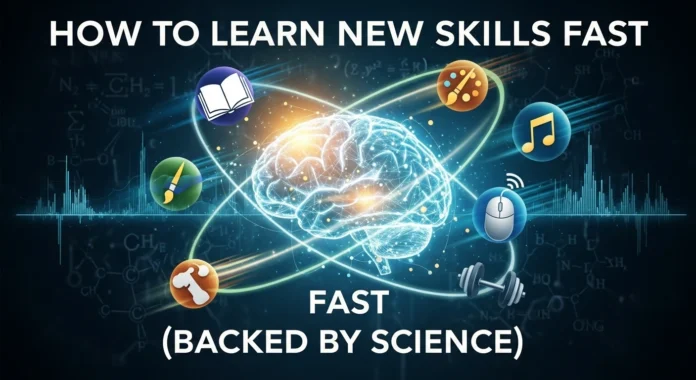Ever feel like you’re falling behind? In a world that changes at lightning speed, the ability to learn new skills quickly isn’t just a nice-to-have; it’s your secret weapon for staying relevant and getting ahead. Whether you’re trying to learn a new language, master a programming language, or finally pick up the guitar, the old way of “practice makes perfect” isn’t enough. You need to practice smart.
The good news? Science has cracked the code on accelerated learning. Let’s dive into the proven strategies that can turn you into a learning machine.
Why Bother Learning Fast? The Need for Speed in a Changing World
Think about it—the job you have today might not exist in ten years. The technology you use is constantly evolving. To thrive, you need to be adaptable, and that means being a fast learner.
But many of us still rely on outdated and inefficient methods we picked up in school, like rereading notes for hours on end.
This isn’t just slow; it’s often ineffective. By adopting scientifically-backed techniques, you can absorb information faster, retain it longer, and apply it more effectively in the real world.
Step 1: Deconstruct the Skill (Don’t Boil the Ocean)
When you look at a new skill, it can feel like a giant, overwhelming mountain. Trying to learn “how to code” or “how to speak Spanish” all at once is a recipe for disaster.
The first step, backed by cognitive psychology, is deconstruction. Break that massive skill down into its smallest, most manageable parts. For example, instead of “learning guitar,” you might break it down into:
- Learning the names of the strings
- Practicing the four most common chords (G, C, D, Em)
- Learning a simple strumming pattern
- Switching between those four chords
By breaking it down, you demystify the process and create a clear roadmap of small, achievable wins.
Step 2: Apply the 80/20 Rule to Pinpoint What Matters
Have you heard of the Pareto Principle, or the 80/20 rule? It states that, for many outcomes, roughly 80% of the consequences come from 20% of the causes. This principle is a game-changer for learning. Your goal is to identify the critical 20% of the sub-skills that will give you 80% of the results you want.
For instance, linguists have found that learning the 2,000 most common words in a language can help you understand about 80% of everyday conversations. Why spend months memorizing obscure vocabulary when you can focus on what truly matters first?
Step 3: Master the Art of Deliberate Practice
Mindlessly repeating an action for hours isn’t effective learning; it’s just reinforcement of existing habits (good or bad). The key to rapid improvement is deliberate practice. This isn’t about quantity; it’s about quality. Deliberate practice involves intense focus on a specific sub-skill, constantly pushing yourself just beyond your current comfort zone.
A crucial element is getting immediate feedback. You need to know right away if you’re doing something correctly or incorrectly so you can adjust. This could be a language partner correcting your pronunciation or a coding program telling you there’s an error.
Step 4: Use Your Brain’s “Save” Button with Smart Retention Hacks
Learning something is one thing, but making it stick is another. Your brain is constantly trying to forget things it deems unimportant. To signal that a new skill matters, you need to use proven memory techniques.
Spaced Repetition: Outsmart the Forgetting Curve
In the 1880s, psychologist Hermann Ebbinghaus discovered the “Forgetting Curve,” which shows how quickly we forget information if we don’t try to retain it.
Spaced repetition is the perfect antidote. It involves reviewing information at increasing intervals—for example, after one day, then three days, then a week, and so on. This strategic timing tells your brain, “Hey, this is important!” and strengthens the neural pathways for that memory.
Active Recall: The “Pull” Method for Stronger Memory
Passively rereading your notes or watching a tutorial again is far less effective than active recall. This means actively retrieving information from your brain. Instead of rereading a chapter, close the book and try to summarize its key points. Use flashcards to test yourself.
This act of “pulling” the information out, rather than passively absorbing it, forges much stronger, more durable memories. It’s the difference between watching someone lift weights and lifting them yourself.
The Feynman Technique: If You Can’t Explain It, You Don’t Know It
Nobel Prize-winning physicist Richard Feynman had a simple method for deep learning. It has four steps:
- Choose a concept you want to learn.
- Teach it to a child (or pretend to). Use simple language and analogies.
- Identify your knowledge gaps. Where did you get stuck or use complicated jargon? Go back to the source material to fill in those gaps.
- Review and simplify your explanation until it’s crystal clear.
This forces you to truly understand a concept at its core, rather than just memorizing a definition.
Step 5: Embrace Rest and Recovery (Yes, Sleep Is a Learning Tool)
You might think that to learn faster, you need to cram more hours in. The opposite is often true. Your brain needs downtime to process and consolidate what you’ve learned. Sleep is non-negotiable. During deep sleep, your brain replays the neural patterns from your practice sessions, effectively transferring new knowledge into your long-term memory.
Similarly, taking short, structured breaks (like using the Pomodoro Technique—25 minutes of focused work followed by a 5-minute break) prevents burnout and helps you maintain high-quality focus.
Conclusion: Become a Lifelong Super-Learner
Learning new skills fast isn’t about having a genius-level IQ. It’s about having a better strategy. By deconstructing skills, focusing on the 80/20, engaging in deliberate practice, using smart retention techniques, and prioritizing rest, you can dramatically accelerate your learning curve.
So, what new skill will you tackle first? Your journey to becoming a lifelong super-learner starts not with a leap, but with a single, strategic step. Go for it!




